Felt DD30 Fat Bike Review
Winter is coming! That means prime Fat Bike season here in the Northeast. We just received a new Felt Fat Bike that is worth a description to whet your appetite for riding outside through the winter – introducing the Felt DD30 Fat Bike.
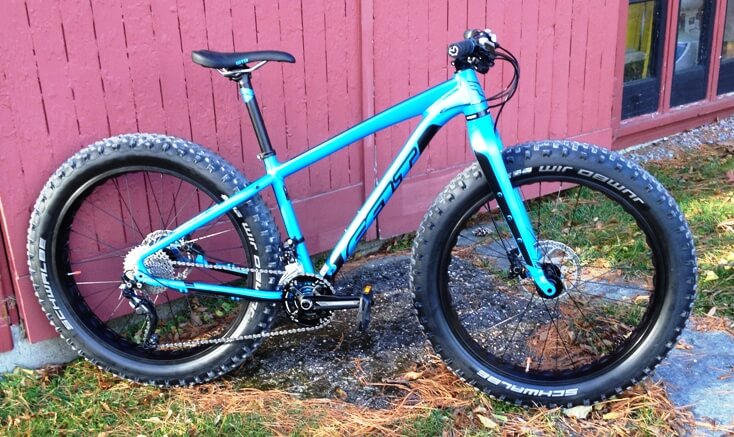 ALUMINUM FRAME AND FORK
ALUMINUM FRAME AND FORK
The frame and fork of the Felt DD30 are constructed entirely of 6061 aluminum, for a good combination of stiffness, weight and price. The headset and fork steerer are tapered for a stiffer, more responsive front end and the geometry is “Bluto” ready if you ever wanted to add a suspension fork like the Rock Shox Bluto to the Felt DD30 in the future. Felt uses a 70 degree headtube angle, which is steeper than many, but actually makes sense if you think about how the heavy fat bike wheels are going to counteract the steeper angle; slack and heavy wheels can often equal sluggish while steep and heavy can equal stable and responsive.
The front axle is 150mm wide, with a 15 mm thru axle while the rear dropouts use the latest 197mm symmetrical spacing to allow for even wider tires than the stock Schwalbe Jumbo Jim 4” tires (a 4.8” tire can be installed with limited rear stay clearance). The 100 mm bottom bracket is threaded, so the chances of creaking bottom brackets are minimal here. All derailleur and brake cabling, except for the front brake, is internal to the frame. The derailleur cable housings run from the shifters, all the way through the frame, even along the chainstay to the rear derailleur, keeping the cable as sealed from the elements as possible. The frame comes in three sizes: Small (16″), Medium (18.5″), and Large (21″) to fit a relatively wide sampling of riders. If we have your fit numbers from a past bike fitting at Fit Werx on file we can help you find the best size with our Rider Matched Approach to bike sizing and selection. If not, our staff is happy to help you find a well suited Fat Bike model and size for your use from our core bike brands including Felt, Fatback, Moots and Surly.
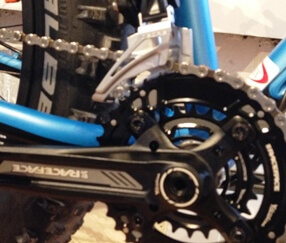 COMPONENTS
COMPONENTS
The components on the Felt DD30 are all Shimano, except for the crankset. The shifters, front derailleur, brake levers, and hydraulic brake calipers are Shimano Deore. The rear derailleur is a Shimano XT Shadow Plus, with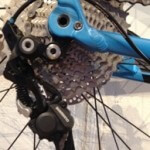 a long derailleur cage mated to a 11-36 rear cassette. The 2x Race Face alloy crankset is a namebrand unit and comes with a 36/22 chainring combination. All the core parts are solid parts that work very well together and should give many years of reliable performance; similar to Shimano’s 105 group on the road, Deore is a good choice for a great working bike on a budget. The 26″ Felt aluminum wheels on the Felt DD30 Fat Bike are shod with Schwalbe Jumbo Jim, 4″ wide tires and the front wheel is equipped with a 180mm brake rotor, while the rear rotor is 160mm. While the Felt DD30 will not take a 5” tire, the 4” is plenty adequate for how most people use their Fat Bike.
a long derailleur cage mated to a 11-36 rear cassette. The 2x Race Face alloy crankset is a namebrand unit and comes with a 36/22 chainring combination. All the core parts are solid parts that work very well together and should give many years of reliable performance; similar to Shimano’s 105 group on the road, Deore is a good choice for a great working bike on a budget. The 26″ Felt aluminum wheels on the Felt DD30 Fat Bike are shod with Schwalbe Jumbo Jim, 4″ wide tires and the front wheel is equipped with a 180mm brake rotor, while the rear rotor is 160mm. While the Felt DD30 will not take a 5” tire, the 4” is plenty adequate for how most people use their Fat Bike.
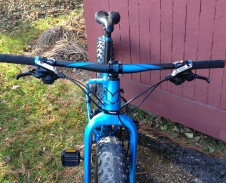 The cockpit of the Felt DD30 is comprised of Felt components. The handlebars are carbon fiber, a very nice touch at this bike’s price point, with a subtle and comfortable 8mm rise and 9 degree sweep. The 9 degree sweep is a nice angle for many people’s wrists. The stem is aluminum, with a 1 1/8″ clamp and the seatpost is 6061 aluminum alloy with a name brand WTB saddle with chromoly rails on top.
The cockpit of the Felt DD30 is comprised of Felt components. The handlebars are carbon fiber, a very nice touch at this bike’s price point, with a subtle and comfortable 8mm rise and 9 degree sweep. The 9 degree sweep is a nice angle for many people’s wrists. The stem is aluminum, with a 1 1/8″ clamp and the seatpost is 6061 aluminum alloy with a name brand WTB saddle with chromoly rails on top.
HOW DOES IT ALL PERFORM?
My usual descriptors when describing the ride of a road bike are pretty much inapplicable with a Fat Bike. With the possible exception of some of the cool eBike Fat Bikes, like the Felt LEBOWSke with its 350 watt motor, Fat Bikes by nature are not going to have lightning quick acceleration. The weight of most Fat Bike wheels, those very large tires and the surfaces and terrain these bikes are designed to tackle, militate against the handling one might expect from a road bike, or even a 27.5″ mountain bike. Fat Bikes are designed to excel in the snow or sand and lower traction/loose terrain in the warm. You’re not going to be hammering along at a 20 mph average speed on a Fat Bike in most cases, that’s for sure.
This doesn’t mean that Fat Bikes are boring though – far from it. Riding a Fat Bike you feel somewhat invincible, like you could go anywhere. Ride down the steps? Well, maybe not for me and my road honed riding experience, but those wide tires made me think that I could! A Fat Bike is sort of like driving a Humvee. There is an indestructible, go anywhere feeling, but a Fat Bike is more practical and versatile than a Humvee.
As it is not snowing yet, I could not ride in the conditions for which this bike was originally designed. However, I can say that I enjoyed my test ride and that riding over 4”x4” wheel stops in the parking lot was cake. The bike handles well and feels very stable and confidence inspiring. The drivetrain components work great together and the brakes provided strong and progressive hydraulic power as one comes to expect from Shimano. While the pedals on the Felt DD30 are basic nylon platforms (easily replaced if they break or a good place to upgrade from the get-go) and the overall weight of the bike came in just under 32 pounds on our scale, this is possibly the lightest feelin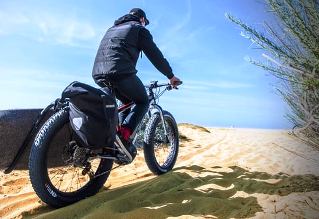 g 32 lbs bike you will ever lift – something about those fat tires just makes you think it will feel heavier than it does.
g 32 lbs bike you will ever lift – something about those fat tires just makes you think it will feel heavier than it does.
As with road and mountain bikes, upgrading the wheels to lighter wheels and tires can make a big difference. Think about this next sentence, and how you will never hear this when discussing a road bike: upgrading the wheels, for example to HED Big Deal or HED B.F.D. carbon wheels and tubeless tires, could save you 4 to 5 Lbs. Yes, POUNDS. Even just converting the existing wheels to tubeless for non-snow riding can save over two pounds of weight. Especially if you are interested in using the bike more as a 3 or 4 season bike rather than a snow only ride, there is a lot of performance to be gained via wheel and tire weight loss on most Fat Bikes. Also, Fat Bikes are far more versatile than many people think; using them when there is not snow on the ground works really well in many cases too.
THE TIRES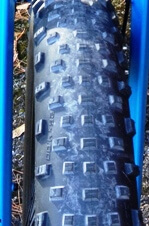
The Schwalbe Jumbo Jim Light 4” tires are lighter than many fat bike tires because of the more rounded and lower profile tread pattern. This is good when it comes to handling on harder pack surfaces and when it comes to reducing weight that stifles acceleration. However, it doesn’t have quite the same dig as a more aggressive tread and riders using the bike in really loose snow may want to opt for a wider and more heavily treaded tire. This being said, for riding on hardpack snowmachine trails and the like, you can just run the pressure low in the 2-4 lbs range on the Jumbo Jim Light to help maximize its traction potential. As stated earlier, the frame with the 197mm rear dropouts can accommodate wider/more aggressive tread if the rider desires.
FAT BIKE ON A BUDGET
The 2016 Felt DD30 sells for $1999 ($1699 for ’17!) and Felt makes three other Fat Bikes in the Felt DD10, with a 6061 aluminum frame and a Rock Shox BLUTO suspension fork, for $3,000; the Felt DD70, with 6061 aluminum frame and fork, a 3 X 9 drivetrain, and mechanical disc brakes, for $1,500 (under $1300 for ’17); as well as the Bosch eBike powered LEBOWSKe at $5800 (having power assist in snow is great and starts under $4K for ’17!). The Felt DD30 strikes a really nice middle ground for many riders as it is a very well equipped bike that is a strong entry into the world of winter riding and the price keeps it in a nice range for many.
Don’t stay on the trainer all winter. Get some fresh air! Contact Us for more information or to set-up a time to take a Felt DD30 (or other) Fat Bike for a spin to find out what the excitement is about.

